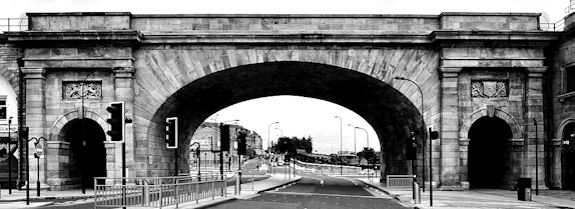
The Wicker, Sheffield S3 8HT
The origins of the name Wicker are uncertain; it is either a reference to the willows that grew on the flat, wet and marshy land on the edge of the River Don or it is derived from wick meaning sinus or angle, thus describing the angular piece of land that lies within a sharp bend of the River Don.
The viaduct was built in 1848 to extend the Manchester, Sheffield and Lincolnshire Railway from its previous terminus at Bridgehouses. The requirements were laid down by Sir John Fowler (engineer; designer of the Forth Bridge), but because of its prominent position in the city, he employed a firm of architects, Weightman, Hadfield and Goldie, to manage the detailed design.
The viaduct was constructed by Miller, Blackie and Shortedge, and consisted of forty one arches. The main arch which crosses the street called The Wicker provides 9.1m (30 ft) of headroom and spans 22m (72 ft). On either side are smaller arches around 3.7m (12 ft) high, with heraldic decoration in the stonework above them. Many of the arches are now concealed by buildings.
On the walls of the Wicker Arch are four carved stone panels, two on each side above the arches over footpaths. One shows a lion and a horse holding a shield with the Latin inscription 'sola virtus invicta'. This was the motto of the Duke of Norfolk and means 'virtue is unconquerable'. On the Burngreave side of the same arch are a horse and a dog with the inscription 'vincit amor patria'. This was the coat of arms for the Earl of Yarborough who was Chair of the Manchester, Sheffield and Lincolnshire Railway.
Later a part of the Great Central Railway, the viaduct supported Sheffield Victoria Station. Main line rail passenger services crossing the Wicker Arches ceased in January 1970 with the closure of Sheffield Victoria and its service to Manchester, however the viaduct still carried the local services to Huddersfield via Penistone until they too were diverted, via Barnsley, in the 1980s. The only other passenger services to cross the bridge thereafter were football excursion trains to Wadsley Bridge for matches played at Sheffield Wednesday's Hillsborough ground. This traffic ceased in 1996. The Victoria station buildings and platforms were demolished in 1989, however freight services continue to use the, now single, line across the viaduct to reach the Stocksbridge Steel works.
The central arch suffered bomb damage during the Second World War, but was repaired. In Spring 2006, the two western-most arches and the bridge over Brunswick Street were removed and replaced by a single steel span, as part of the final phase of construction of Sheffield's Inner Ring Road. The arches were restored in 1990. The structure is Listed Grade II*.
By road: On A6135 in the centre of Sheffield

Barman, Christian, An Introduction to Railway Architecture, Art & Technics, (1950)
Barnes, E. G., Midland Main Line, 1875-1922, Allen & Unwin, ISBN-10: 0043850499 (1970)
Barnes, E. G., The Rise of the Midland Railway 1844-1874, Allen & Unwin, ASIN: B0000CN17S (1966)
Batty, S., Rail Centres: Sheffield, Ian Allan, ISBN 0-7110-1366-7 (1989)
Biddle, Gordon, Britain's Historic Railway Buildings, Oxford University Press, ISBN-10: 0198662475 (2003)
Biddle, Gordon, Great Railway Stations of Britain, David & Charles, ISBN 0 7153 8263 2 (1986)
Biddle, Gordon & Nock, O.S., The Railway Heritage of Britain : 150 years of railway architecture and engineering, Studio Editions, ISBN-10: 1851705953 (1990)
Biddle, Gordon,and Spence, Jeffry, The British Railway Station, David & Charles, ISBN 0 7153 7467 2(1977)
Body, Geoffrey, Railway Stations of Britain: A Guide to Seventy Five Important Centres, Patrick Stephens, ISBN-10: 185260171X (1990)
Butt, R.V.J. The Directory of Railway Stations, Sparkford: Patrick Stephens Ltd. ISBN 1-8526-0508-1. (October 1995, 1st Edition)
Dow, George, The Great Central Railway. Locomotive Publishing Co. (1960)
Fox, Peter, The Midland Line in Sheffield, Platform 5, ISBN 1-872524-16-8 (1990)
Goslin, Geoff, The London Extension of the Midland Railway, Irwell Press, ASIN: B0036KJYOE (1994)
Joy, David, The Regional History of the Railways of Britain: South and West Yorkshire, ISBN 0 7153 6883 4 (1975)
Lloyd, David and Insall, Donald, Railway Station Architecture, David & Charles, ISBN 0 7153 7575 X (1978)
Rolt, L. T. C., The Making of a Railway: Building of the Great Central, Sutton Publishing, ISBN-10: 0750913541 (1997)
Smith, Martin, British Railway Bridges and Viaducts, Ian Allan, ISBN 0 7110 2273 9 (1994)
Sykes, John, The Penistone Line Trail: Station to Station Walks Between Sheffield and Huddersfield, Penistone Line Partnership, ISBN-10: 0954479602 (2003)
Stretton, Clement Edwin, The History of the Midland Railway (1901), Kessinger Publishing, ISBN-10: 1164412388 (2010)
Williams, Roy, The Midland Railway: A New History, David & Charles, ISBN-10: 0715387502 (1988)